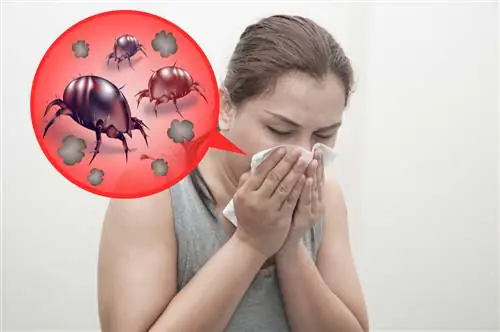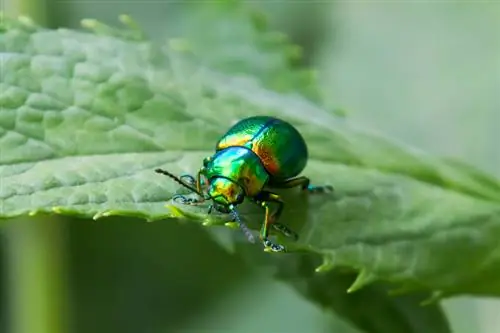- Author admin [email protected].
- Public 2023-12-16 16:46.
- Last modified 2025-06-01 06:02.
The triumvirate of terror is bed bug, mite and flea. As unwanted bedfellows, these vermin turn the dream of undisturbed sleep into a nightmare. The stubborn parasites will not leave the field voluntarily. This guide explains in a practical and comprehensible way how you can clearly identify pests in bed and successfully combat them.
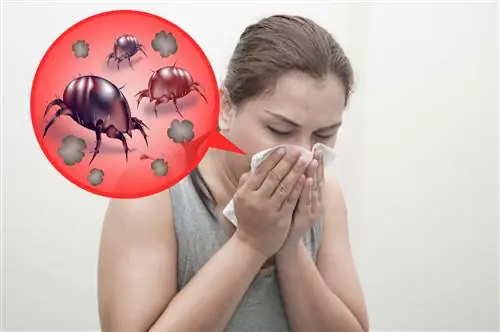
What to do if there are bugs in bed?
Bed bugs bite, fleas bite, mites can cause allergies. All three pest species die when there is frost. You can get rid of mites in the washing machine at 60 °C. To combat fleas, add s alt and vinegar to the washing powder. Only an exterminator can help against betting bugs.
- Bed bugs bite, are 5-7 mm small, reddish-brown, flat-oval, wingless, nocturnal and common vermin in bed.
- White bugs in bed are 0.1-0.5 mm small mites that feed on scales, do not sting or bite.
- Yellow-brown, 1-3.5 mm fleas sting and can be recognized as jumping vermin in bed.
What kind of bugs are there in bed?
Two types of parasites make our lives hell as blood-sucking vermin in bed. A third type of pest is omnipresent throughout the house and prefers to colonize mattresses and bed linen. The more specifically you can identify the pest, the more effective the countermeasures will be. The following overview sums up how you can recognize the three most common pests in your bed:
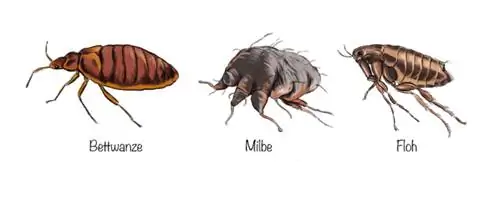
| Distinguishing features | Bed bugs | Mites | Fleas |
|---|---|---|---|
| Size | 5-7mm | 0, 1-0, 5mm | 1-3, 5mm |
| color | brown, reddish-brown | white | yellowish, yellow-brown |
| Body shape | flat, roundish | oval to oblong | flattened on the side |
| Symptoms | + bite wounds | + Breathing problems | + Stitches |
| + red wheals | + Itching | + reddish papules | |
| + severe itching | + Allergies | + Itching | |
| Indications | + black feces crumbs | + tiny feces particles | + jumping fleas |
| + red blood stains | + Eggs, larvae in bed cracks | ||
| + molt remains | + dark poop pills | ||
| Smell | repulsive, sweetish | no smell | no smell |
Have the clues in this table put you on the right track? Then please take a look at the pictures below. The pictures show bed bugs, mites and fleas in comparison. You can read more in-depth information with useful tips for precise pest identification in the following sections.
Identifying bed bugs
Bed bugs (Cimex lectularius) are nocturnal bloodsuckers and masters of camouflage. The crawling insects have a flat-oval body shape and move forward with 6 hairy legs. The parasites are activated by the outflowing body heat of sleeping people and the exhaled CO2. In search of a blood meal, bed bugs leave their hiding place, crawl around on the skin and bite. Rarely, the bed bug immediately hits a blood vessel. As a result, the characteristic bug streets with bite wounds arranged in rows arise. Uncovered and covered body regions are affected:
- Neck, shoulders
- Face, neck
- Arms
- Legs
- Feet
Bed bug bites are not painful. However, victims suffer from red swelling and itching the next day. If there are further indications of 0.5-1 mm small feces particles in the bed, under carpets or behind wallpaper, there is hardly any doubt that there are bed bugs infestation. Blood stains and remains of skin are additional indications, but can also have other causes. However, if you notice a disgusting, sweet smell in your bedroom, immediate action is required. Bed bugs stink to high heaven. The larger the population, the more beastly the smell.
Detecting mites

House dust mites are infinitesimally small
White bugs in bed are usually a population of house dust mites (Dermatophagoides). Use a magnifying glass to identify the nuisances. The white, tiny body is covered in bristles. A finely striped body cover can be seen under the bristles. Mites live in high concentrations in mattresses and pillows. The feces balls as an aid to identification also require looking through a strong magnifying glass. One gram of house dust can contain up to 250,000 such fecal particles.
House dust mites in bed do not sting and cannot bite. The pests' diet includes human skin flakes, which can be found in large quantities in mattresses, pillows and duvets. When searching for food at night, direct skin contact occurs with the involuntary human donor. For most people this works out well. Sometimes white bugs in bed have unpleasant consequences. Allergy sufferers suffer from asthma or dermatitis if they have to spend the whole night in the company of mites.
Detecting fleas
Are jumping bugs in bed robbing you of your well-deserved night's sleep? Then you are dealing with fleas. The main suspect is the human flea (Pulex irritans) from the large family of fleas. Other candidates include the cat flea (Ctenocephalides felis) and the dog flea (Ctenocephalides canis). The blood-sucking parasites are characterized by an impressive jumping ability. The wingless bodies are equipped with powerful hind legs that allow jumping distances of up to one meter.
A typical identifying feature is a robust exoskeleton. The yellowish-brown body has armor made of shingled chitin plates. For this reason, you can rarely squash a flea between your fingers. Stinging bugs in bed are usually fleas because the parasites sting and don't bite like bed bugs do.
Where do bugs in bed come from?
The fight against bugs in bed becomes a vicious cycle if you don't identify the cause and eliminate it. You can avoid biting and stinging pests in particular if you are aware of the following three most common causes:
Cause No. 1 - willingness to travel

Bed bugs like to travel as stowaways
Bed bugs are not native to our regions but are still widespread. The reason is the pronounced love of traveling. Germany and China regularly compete head-to-head for the title of world travel champion. The flip side of the coin is that people returning home often have bed bugs in their luggage as stowaways. They caught the beasts in hotels, holiday homes or sleeping cars. Bed bugs are often uninvited travel companions, especially for backpackers who sleep in a different place every night.
Cause No. 2 - Used goods
Used furniture, antiquarian books, old carpets and second-hand clothing are often contaminated by vermin. Unfortunately, fleas can starve for many weeks and months without suffering any damage. Bed bugs can survive without a blood meal for up to 1.5 years. The parasites wait patiently until a careless buyer takes the used goods home without checking and cleaning them.
Cause 3 - Pets, bird nests, nesting boxes
Jumping bugs in bed are usually a souvenir from your pets. Cunning fleas use dogs and cats as a convenient means of transport into the house. People can catch the pests while gardening, as bird nests and nesting boxes are popular retreats for bed bugs, fleas and mites.
Tip
Frankfurt Airport is showing the way. For worried travelers, trained four-legged sleuths are available to track down introduced bed bugs. If requested, dog handler Larry Hudson will come with his sniffer dog team. The specialists join forces to carefully search for suspicious pieces of luggage. In Berlin, pest controller Adam Tesmer has his terrier Taylor in tow, who signals the presence of bed bugs with unmistakable instinct.
How to get rid of bugs in bed?
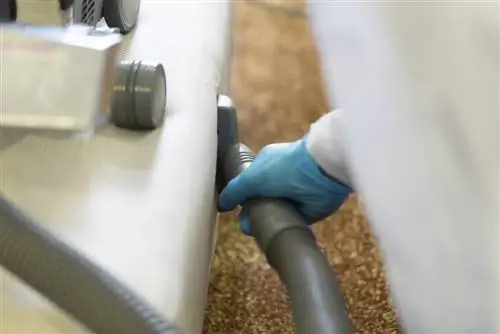
Suctioning significantly reduces the number of mites
Identifying vermin in bed is just the prologue to successful control. Have you uncovered the culprits robbing you of your night's sleep? Then you have specific methods at your disposal as a counteroffensive. The following table provides an overview of how you can successfully combat bed bugs, mites and fleas:
| Bed bugs | Mites | Fleas |
|---|---|---|
| Exterminator | ventilate | Suction with HEPA filter |
| Heat (50° Celsius) | Washing at 60° Celsius | Washing with washing powder, s alt, vinegar |
| Cold (-18° Celsius) | Freeze pillows | Clean mattress with steam cleaner |
| Suction with HEPA filter | Treat pets | |
| Treat mattress with steam cleaner | Set up a flea trap | |
| New mattress every 7 years | ||
| Waterbed |
The control measures mentioned deliberately avoid the use of pesticides of any kind. A chemical spray against vermin in the immediate living environment poses he alth risks for you and your family that go far beyond redness, swelling and itching.
Excursus
Bed bugs do not transmit diseases
The good news for those affected is: bed bugs do not transmit disease. Bites, skin swelling and itching are very unpleasant. However, the beasts don't carry any viruses with them like ticks do. As a rule, bed bug bites can be easily treated with over-the-counter ointments. Excruciating itching is relieved by active ingredients such as cortisone. However, if massive swelling and unbearable itching occur, it may be an allergic reaction. In this case, your family doctor should be contacted.
Fighting bed bugs

If there is a severe infestation, an exterminator should be called
Were you able to identify bed bugs as vermin in bed? Then you have to deal with tough opponents. The experts from the Federal Environment Agency strongly advise against private experiments with home remedies or pesticides. Renowned researchers have discovered that bed bugs are now resistant to numerous commercially available insecticides. To make matters worse, the countless eggs in your bed cannot be destroyed by any known means. In the face of such a stubborn squadron, laypeople are fighting a losing battle.
In an emergency, please contact a certified pest controller or exterminator. The professionals use a sophisticated combination method to combat bed bugs. Using a special device, the room temperature in the bedroom is heated up to 55° Celsius. At temperatures as low as 45° Celsius, bed bugs' metabolism breaks down and the bugs die.
Areas in the bedroom that are difficult to heat, such as carpets, laminate or PVC, are first heated to 35° Celsius in order to mobilize hidden bed bugs. This trick exploits the insect's reflexive mechanism to respond to moderate increases in temperature because it senses a human blood donor. Instead of a blood meal, however, the exterminator is waiting in front of the hiding place with a special spray that is fatal to bed bugs.
The flip side of the coin is that the hidden eggs cannot be destroyed using the combination method. It is therefore necessary to wait some time until the larvae hatch and to use the control again. That's why eliminating bed bugs can take many weeks and months.
Support professional pest control
Those affected by a bed bug infestation can help professionals combat it with effective immediate measures. This makes sense because in this way you are making a contribution to reducing the use of insecticides and eliminating the pest more quickly. The experts from the Federal Environment Agency recommend the following methods, among others, in a comprehensive flyer:
- Freezing: freeze infected objects for 3 days at -18° Celsius
- Heating up: place contaminated mattresses, pillows and bed linen in the sauna for 1 hour at 50° Celsius
- Suction: Vacuum bed bugs with a vacuum cleaner, close the bag tightly, freeze for 24 hours and throw away
It is important to note that you do not bring items from the bedroom into neighboring rooms. In this way you make the bedbug infestation worse because the bugs can spread explosively there.
Fighting mites in bed
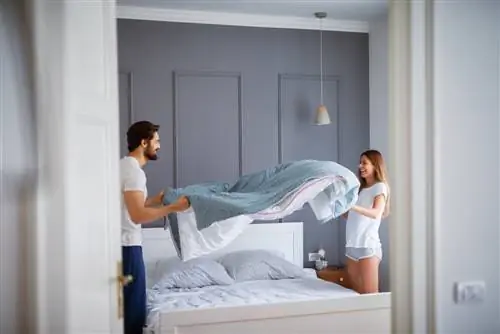
Regular airing reduces house mites in bed
Fresh air is anathema to mites in bed. Daily ventilation is therefore a must if you want to get rid of the pests. The bed should only be made after it has been aired so that any moisture that has accumulated during the night can escape. The following measures have proven to be effective in practice if you want to combat small vermin in your bed without using toxic spray:
- Make your bed fresh regularly
- wash used bed linen at 60°
- Just uncover the bed in the morning, ventilate it well, then shake it up
- Wash decorative pillows, cuddly toys or put them in the freezer
- Clean the bedroom daily with a vacuum cleaner and HEPA filter
If the mites in bed linen and pillows become too restless, the pests retreat into the mattress. To get rid of the rabble here, you can have the mattress cleaned every quarter. Of course, this measure only curbs mite infestation. Experts believe that after five to seven years a mattress will have a peak of up to 1.5 million mites, making replacement advisable. You can solve the problem more effectively and ultimately cheaper with a waterbed.
Get rid of fleas in bed
Determining jumping bugs in the bed as fleas can be done in just a few minutes. The procedure takes much longer to combat the bloodsuckers successfully and without chemicals. The table above lists tried-and-tested methods that you should use in a sensible sequence of steps and at short time intervals. How to get rid of fleas in bed:
- Mix washing powder with 1 teaspoon of s alt and 1 good dash of vinegar
- Remove the bed linen and wash at 60° with the washing powder mixture
- Remove the mattress from the bed and treat it with a steam cleaner
- Bed frame, rug, floor, walls and curtains vacuum with vacuum cleaner
- Take the vacuum cleaner bag out of the device, tie it tightly, freeze it overnight and dispose of it in the residual waste bin
Repeat this process every 3 to 5 days for a period of 8 weeks. Such a long period of time ensures that the larvae hatch from existing eggs and are targeted by the control.
Supportive measures
Do you share your life with a dog or cat? Then you probably have your four-legged friend to thank for the blood-sucking bedfellows. In parallel to fighting bugs in the bed, you should treat your pet with an anti-flea treatment from the vet. Please also wash dog and cat blankets every few days with a mixture of washing powder, s alt and vinegar.
A flea trap serves as a control instrument and at the same time reduces the infestation pressure. You can build the trap yourself. To do this, fill a shallow bowl with water, add one to two tablespoons of dish soap and stir the liquid. Place the bowl on the floor next to your bed and shine a lamp on it. The fleas are attracted to the light, hop into the trap and sink because the detergent has reduced the surface tension of the water. Experience has shown that lamps with a yellow-green light source attract significantly more vermin.
Frequently asked questions
How do you recognize bugs in bed?

Itching in the morning may be caused by bugs
Bites, stings and itching are the first indications of bugs in bed. Since bed bugs and their ilk are nocturnal, you will rarely catch the pests in the act. You can detect an infestation by carefully checking your bed and bedroom. Look for fecal crumbs, red blood spots, small scales and tiny eggs or cream-colored larvae in any hidden, dark places.
Is there a spray against bugs in bed?
Specialist retailers have numerous varieties of insecticides against bugs in the bed. When using it in the bed and bedroom, it is important to consider the partly unclear chemical and he alth-endangering components. A spray against bed bugs in particular only works if it is sprayed directly onto the insects. Applying the expensive product to hiding places, nests and walkways is not successful, but simply pollutes the air in the room. Furthermore, the eggs are immune to any spray.
How long does it take for my bed to be free of bed bugs?
Combating a bed bug infestation usually requires several treatments every two weeks. Depending on the intensity of the infestation and your cooperation, it can take three to six months for your bed to be declared a bug-free zone.
What can I do to avoid bringing bed bugs into my bedroom while on vacation?
When you arrive at your hotel room, you should never unpack your luggage in the immediate vicinity of your bed. Any bed bugs that may be present are just waiting to crawl into your suitcase. Keep your luggage tightly locked during your vacation. Regularly inspect the bed and room for signs such as feces crumbs or dead bugs in cracks. When you return home, ideally store your suitcases as far away from the bedroom as possible.
Is bugs in bed a sign of poor hygiene?
No. Infestation with bugs in bed has no direct connection to cleanliness. Bed bugs get into the house through luggage, old furniture and junk. Mites are also present where cleaning and vacuuming are carried out every day. Annoying fleas boldly invade living spaces, regardless of the hygienic condition.
Tip
Double-sided adhesive strips are a good tool if you want to identify bugs in bed. Attach adhesive strips to the bed frame, headboard and feet. During their nocturnal forays, the parasites stick and can be identified without any doubt.

